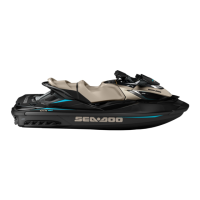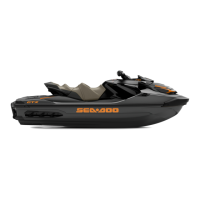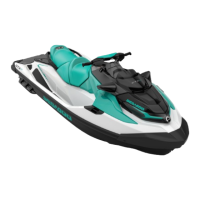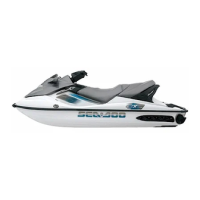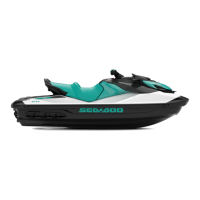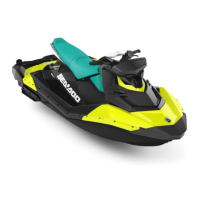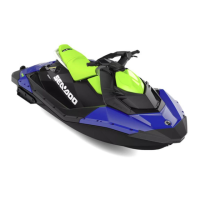Section 08 ENGINE MANAGEMENT (4-TEC)
Subsection 02 (COMPONENT INSPECTION AND ADJUSTMENT)
To check fuel rail for leaks, first pressurize the sys-
tem then spray soapy water on all hose connec-
tions, regulators and injectors. Air bubbles will
show the leaking area. Check also for leaking fuel
or fuel odor.
WARNING
If any gasoline leak and/or odor are present,
do not start the engine. Repair the leak.
WARNING
Never use a hose pincher on high pressure
hoses.
There is a valve on fuel inlet hose connected to the
fuel rail. This valve is for manufacturing purpose
only.
WARNING
PRESSURIZED FUEL. Do not unscrew protec-
tive cap. Do not operate the watercraft with-
out cap properly installed.
ELECTRICAL SYSTEM
It is important to check that the following electrical
system components are functioning properly:
– battery
– fuses
– DESS
– ignition (spark)
– ground connections
– wiring connectors.
It is possible that a component seems to operate
in static condition but in fact, it is defective. In
this case, the best way to solve this problem is
to remove the original part and replace it with one
which is in good condition.
Never use a battery charger to substitute
temporarily the battery, as it may cause the
MPEM/ECM to work erratically or not to work at
all. Check related-circuit fuse solidity and condi-
tion with an ohmmeter. Visual inspection could
lead to false results.
WARNING
All electrical actuators (idle bypass valve,
TOPS valve, injectors, fuel pump, ignition
coils and starter solenoid) are permanent-
ly supplied by the battery when the safety
lanyard is installed. Always disconnect the
battery prior to disconnecting any electrical
or electronic parts.
To perform verifications, a good quality multimeter
such as Fluke 111 (P/N 529 035 868) should be
used.
Payparticularattentiontoensurethatterminals
are not out of their connectors or out of shape.
The troubleshooting procedures cover problems
not resulting from one of these causes.
WARNING
Ensure all terminals are properly crimped on
wires and connector are properly fastened.
Before replacing a MPEM or ECM, always check
electrical connections. Make sure that they are
very tight and they make good contact and that
they are corrosion-free. Particularly check MPEM
and ECM ground connections. Ensure that con-
tacts are good and clean. A “defective module”
could possibly be repaired simply by unplugging
and replugging the MPEM or ECM. The voltage
and current might be too weak to go through dirty
wire terminals. Check carefully if terminals show
signs of moisture, corrosion or if they look dull.
Clean terminals properly and then coat them prior
to assembling as follows:
NOTE: Do not apply dielectric grease or any other
lubricant on the ECM or MPEM connectors.
Other connectors: Apply a silicon-based dielectric
grease or other appropriate lubricant. If the newly
replaced MPEM or ECM is working, try the old one
and recheck if it works.
Ensure that all electronic components are genuine
- any modification on the wiring harness may lead
to generate fault codes or bad operation.
NOTE: For diagnostics purposes, use Vehicle
Communication Kit (VCK). See DIAGNOSTIC
PROCEDURES subsection.
After a problem has been solved, ensure to clear
thefault(s)intheECMusingtheVCK.Referto
DIAGNOSTIC PROCEDURES subsection.
404 smr2004-Complete Line Up

